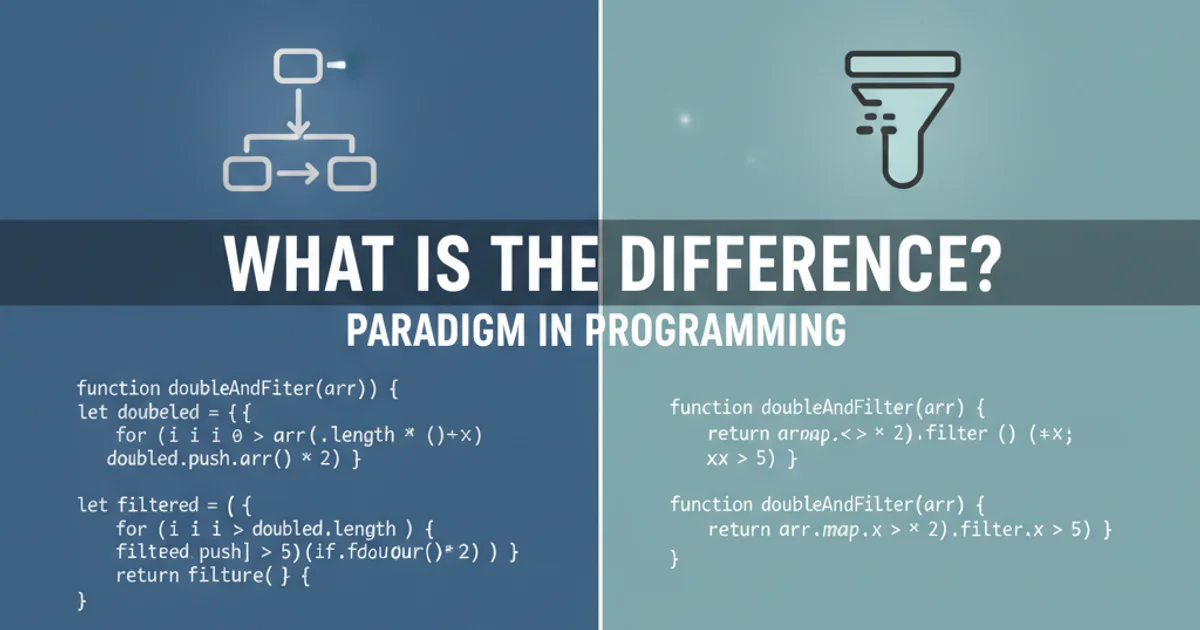What is the difference between declarative and imperative paradigm in programming?
Categories:
Declarative vs. Imperative Programming: Understanding the Core Differences

Explore the fundamental distinctions between declarative and imperative programming paradigms, their advantages, disadvantages, and practical applications in modern software development.
In the vast landscape of software development, understanding different programming paradigms is crucial for writing efficient, maintainable, and scalable code. Among the most fundamental distinctions are imperative and declarative programming. While both aim to achieve a desired outcome, they approach problem-solving from entirely different philosophical standpoints. This article will delve into these two paradigms, illustrating their core differences, providing practical examples, and discussing when to choose one over the other.
Imperative Programming: The 'How-To' Guide
Imperative programming focuses on how to achieve a result. It describes the control flow of the program in explicit steps, detailing every instruction the computer must execute to reach the desired state. Think of it as providing a recipe with precise, step-by-step instructions. The programmer is responsible for managing the program's state and explicitly telling the machine what to do at each stage.
Key characteristics of imperative programming include:
- Explicit Control Flow: The order of operations is clearly defined.
- State Mutation: Programs often involve changing the state of variables.
- Step-by-Step Instructions: Focus on a sequence of commands.
- Common in Procedural and Object-Oriented Languages: Languages like C, Java, and Python often employ imperative styles.
List<int> numbers = new List<int> { 1, 2, 3, 4, 5 };
List<int> evenNumbers = new List<int>();
foreach (int number in numbers)
{
if (number % 2 == 0)
{
evenNumbers.Add(number);
}
}
// evenNumbers now contains [2, 4]
An imperative C# example to filter even numbers from a list.
flowchart TD
A[Start]
B{Initialize empty list 'evenNumbers'}
C{Loop through each 'number' in 'numbers'}
D{Is 'number' even?}
E[Add 'number' to 'evenNumbers']
F[End Loop]
G[End]
A --> B
B --> C
C --> D
D -- Yes --> E
E --> C
D -- No --> C
C --> F
F --> GFlowchart illustrating the imperative process of filtering even numbers.
Declarative Programming: The 'What' You Want
Declarative programming, in contrast, focuses on what the program should accomplish, rather than how it should achieve it. You describe the desired outcome or the properties of the result, and the system (language runtime, framework, or library) figures out the execution steps. It's like ordering a meal at a restaurant: you state what you want to eat, and the kitchen staff (the system) handles the intricate steps of preparation.
Key characteristics of declarative programming include:
- Focus on Desired Outcome: You specify the target state or data transformation.
- No Explicit Control Flow: The execution order is often abstracted away.
- Minimized Side Effects: Often promotes immutability and pure functions.
- Common in Functional, Logic, and SQL Languages: Examples include SQL, HTML, CSS, Haskell, and LINQ in C#.
List<int> numbers = new List<int> { 1, 2, 3, 4, 5 };
// Using LINQ (Language Integrated Query) - a declarative approach
List<int> evenNumbers = numbers.Where(number => number % 2 == 0).ToList();
// evenNumbers now contains [2, 4]
A declarative C# example using LINQ to filter even numbers.
flowchart TD
A[Input List 'numbers']
B{Define condition: 'number' is even}
C[Filter 'numbers' based on condition]
D[Output List 'evenNumbers']
A --> B
B --> C
C --> DFlowchart illustrating the declarative approach to filtering even numbers.
for loops (imperative) and array methods like map, filter, reduce (declarative).When to Choose Which Paradigm
The choice between imperative and declarative programming often depends on the specific problem, the language being used, and the desired level of abstraction. Neither paradigm is inherently 'better' than the other; they simply offer different tools for different jobs.
Choose Imperative when:
- You need fine-grained control over the execution process and resource management.
- Performance optimization requires explicit step-by-step manipulation.
- The problem naturally lends itself to a sequence of operations (e.g., low-level system programming, algorithms with complex state changes).
Choose Declarative when:
- You want to express complex logic concisely and readably.
- The underlying system can optimize the 'how' more effectively than you can manually (e.g., database queries, UI rendering).
- Maintainability and reducing side effects are high priorities.
- Working with data transformations or defining desired states (e.g., configuration files, UI components).
Conclusion
Understanding the difference between imperative and declarative programming is fundamental for any developer. Imperative programming gives you explicit control over the execution flow, detailing every step. Declarative programming allows you to describe the desired outcome, letting the system handle the implementation details. By recognizing the strengths of each, you can make informed decisions that lead to more robust, efficient, and maintainable software solutions.